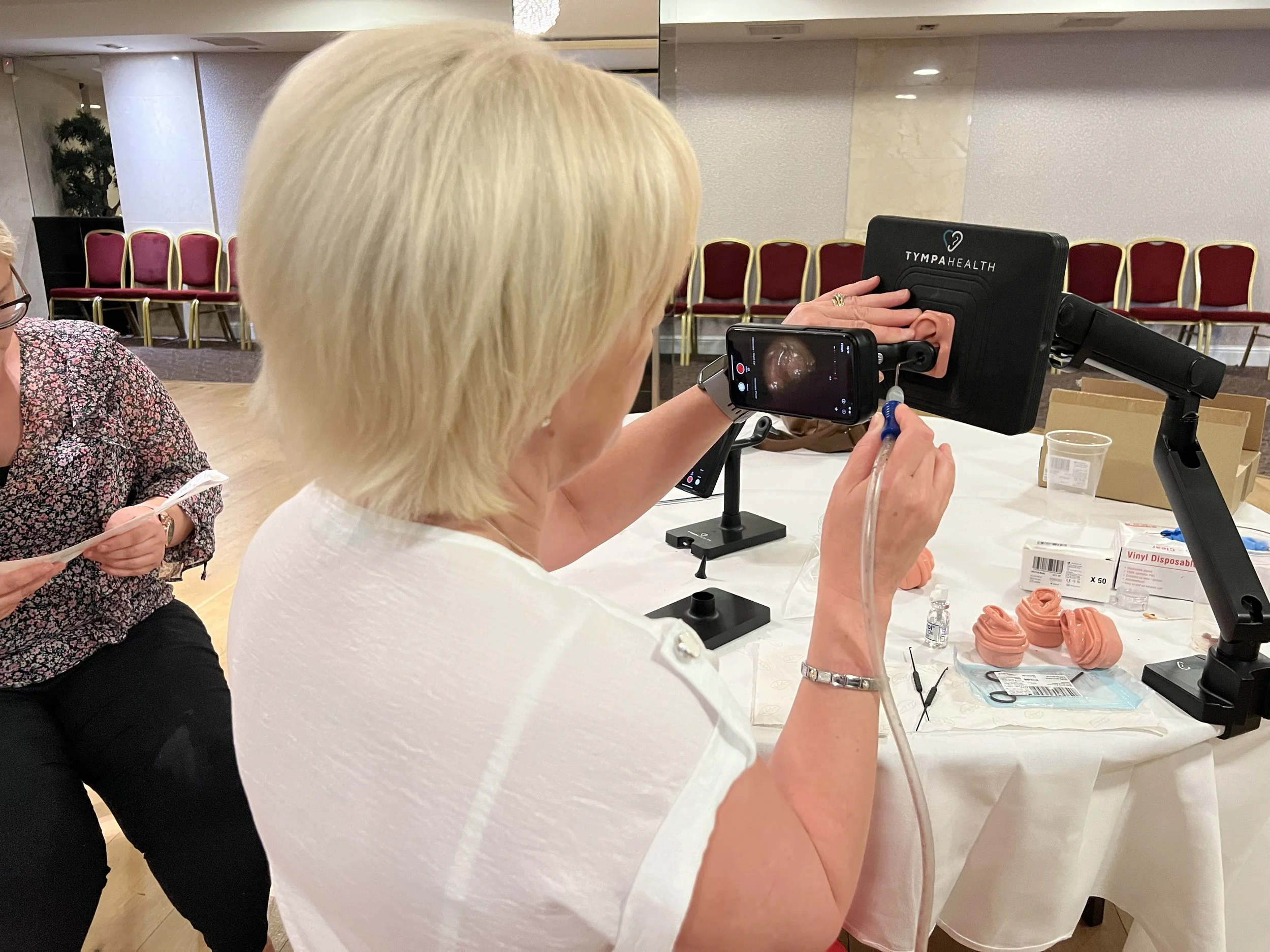Interview with Ms Tina Fagan, Vitalis Health Care Assistant.
In this blog Ms Tina Fagan, Vitalis Health clinician, is interviewed about the micro suctioning ear wax removal technique. She recently got training in this technique in Dublin with Tympa Health. She talks about the process and offers suggestions as to how to prevent problems arising.
Tina at micro ear suctioning training in Dublin.
So, Tina, how did you find your recent training in ear-wax removal using the micro suctioning technique?
I really enjoyed it. It was a full-on two day course. The trainer was amazing, really hands-on, theoretical learning and a lot of practical learning with volunteers getting their ears microsuctioned under the supervision of the tutor. It was so interesting to learn all about the inner workings of the ear. We got trained in autoscopy, a camera guided procedure for inspecting the inner ear.
Can you tell me why Vitalis wanted to train in micro suctioning?
The Tympa micro suctioning technique is less evasive than irrigation.
We are able to show the patients photos and videos of inside their own ear, so they are empowered to understand exactly what is going on.
We have support from Tympa. If there is anything we are unsure about we can contact Tympa for expert opinion. If they are not sure then they will contact a further ear specialist so we are really well equipped to care for our patients in this area now. We don’t have to refer the patient to get another appointment in an audiology specialist, we can get second and third opinions ourselves there and then.
What is the process you go through in Vitalis when a patient comes for ear suctioning?
When a patient comes in to me we have a consultation. I ensure they have prepared for the appointment by putting oil in their ears each night for a week to soften the wax.
I ask them if they have any pain in their ears, and if they have any tinnitus or dizziness. This is to check if what they have is actually an ear infection rather than just a build up of wax.
I ask if they have had their ears examined by a doctor because we only see patients who have a referral.
I inform the patient about the process and ensure they are informed about any risks. Sometimes people can be alarmed at the clarity and volume of their hearing after the procedure. This settles down but we ensure that the patient is aware of this.
Then we begin the camera guided procedure in each ear to inspect the ear’s interior. We do that to confirm if wax is present. I show the patient a video and photos and we discuss what we find. Then I get their consent to proceed and we go ahead with the process.
The technique involves a pattern of suctioning and regular re-examination to continue to check the progress.
We also give after-care advice. This differs from case to case but often I advise people to keep their ear dry afterwards. Sometimes the wax being removed will expose an infection so then we can prescribe ear drops or suitable treatment according to the doctor’s inspection and diagnosis.
Is this something everyone should get done?
No. Everyone needs their earwax, it’s there for a reason! First, it protects and moisturises the skin of ear canal, it contains special chemicals that fight off infections that could hurt the skin inside the ear canal and it acts as a shield between the outside world and the eardrum. So it’s important we leave some ear wax in the ear.
It’s also important not to use cotton buds! Cotton buds can cause a variety of ear problems, including things like earwax impaction, injury, and infection. If you are experiencing the sensation of having blocked-up ears, I would advise to use some olive oil in your ear for a week.
It’s only if it’s getting problematic that you should seek to get earwax removed by micro suctioning via a referral from your GP .
Do you have any tips to prevent problems occuring?
If you swim or use a sauna or do a lot of sport which would make you produce a lot of sweat it’s important that you dry your ears slowly (with a hair dryer for example).
In the pool or sea you can wear ear plugs.
People who wear hearing aids may be more likely to have problems. This is because not only does the hearing aid tend to stimulate the cerumen glands in the ear, producing more earwax, but it can also sometimes stop the wax from naturally clearing out of the ears. This is also the case for anyone who wears inner ear ear phones a lot.
Have you already had some patients come Vitalis to get micro suction ear removal?
Yes it is already very popular and we have had a lot of appointments for ear suctioning ear wax removal, people from all over. There have already been very good results. A man last week said - “Oh I can hear clearly again!” It’s fantastic that we can offer such specialised support to our patients.
Dr Siobhan Graham and Health Care Assistant Ms Tina Fagan have been trained in the Tympa system which empowers clinicians to deliver digital otoscopy and microsuction wax removal, in a single appointment. This treatment is suitable for anyone 16 years of age and over.
In some cases we may use both irrigation and suctioning depending on the nature of the ear wax.
Click HERE to book your 45 minute appointment with Tina Fagan.
Vitalis Health provides ear wax removal services to patients from Belfast and the greater Belfast area such as Lisburn, Dunmurry, Carryduff, Glengormley, Newtownabbey, Jordanstown, Bangor, Holywood. We also welcome patients from further afield for ear wax removal such as Larne, Banbridge, Antrim, Coleraine, Downpatrick, Strabane, Cookstown, Omagh, Enniskillen, Armagh City, Dromore and Ballymena.




